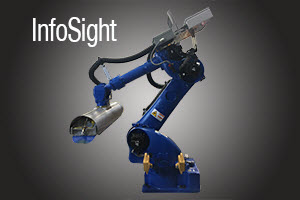When I think of robots, my first thought is always something like “Rosie” from the Jetsons. Even now, working at InfoSight and having been around the common robotic arm used to move and use various tools to perform repeatable tasks, Rosie still pops into my head. Just for fun, I looked her up and found this 2019 article from Emerging Ed Tech about all the cool stuff from the Jetsons that are common to us now. You can read that here.
The reality is that common industrial robots look nothing like Rosie but are still used to do jobs that are easily repeatable or dangerous for humans. Using automated systems to identify metal products is more efficient, more accurate, and safer - this is InfoSight’s specialty. Many of our marking technologies are designed for very hot products (over 1000oF/540oC). They create different messages on each piece, including unique serial numbers and barcodes, in seconds. Information is downloaded directly from the customer’s system, eliminating the chance of human error. This can all be accomplished with traditional or robotic automation.
InfoSight began using robots several years ago. One of the earliest applications of a robot in an InfoSight system was for a bar and pipe spray marking system. This customer required up to 16 different colors sprayed in specific variable patterns on the ends of pipes and bars. A second robot was added for end painting, colorband painting, and positioning a camera for remote visual inspection of pipes. The available space in the customer’s plant was very small, making the robot the perfect solution. It included interchangeable End of Arm Tools (EOAT), of which most were spray nozzles to accommodate all of the colors. One of the tools was the camera and a laser sensor for detecting the position of the product.
The small available footprint and quick cycle time is a common driving factor for using robotic automation. In another application, InfoSight needed to mark the inside diameter of the tailing end of one pipe and the leading end of the next. InfoSight utilized our direct laser marking technology which includes a special white patch that is darkened with a laser to create the message. The EOAT included all of the marking components in a tube that rotated 180o to mark then leading end of one pipe, turn around, and mark the tailing end of the previous. Watch the Robotic Inside Diameter Laser Marking System here.
In another recent application, InfoSight incorporated an InfoDent® 8400 stamping head on a robot for a hot plate marking system. The robot remains behind a heat shield until the plate is in marking position. The robot uses a laser sensor to detect the trailing edge of the plate and then moves the stamper out to the plate and marks in multiple locations on the 2000oF (1100oC) plate. Watch the Robotic Plater Marking System here.
While InfoSight is not sending Rosie to clean your house, we can integrate any of our marking technologies onto a robot, providing customers with custom automated marking systems with small footprints and quick cycle times. Contact us today to learn how we can help you.

